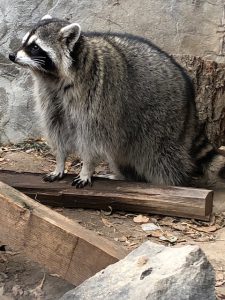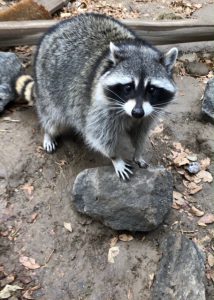Raccoon (Procyon lotor)
Taxonomy
Kingdom: Animalia
Phylum: Chordata
Class: Mammalia
Order: Carnivora
Family: Procyonidae
Genus: Procyon
Species: Procyon lotor
Conservation Status in Idaho
Least concern
Range and Habitat
Raccoons are found across southern Canada, the United States, and into northern South America. Raccoons are highly adaptable living in multiple habitats including urban areas. They require access to water and prefer woodland areas.
Physical Features
Weight: 4.0–23.0 lbs (1.8–10.4 kg)
Height: 9.0–12.0 in (23–30 cm)
Length: 2.0–3.0 ft (60.3–90.5 cm)
Tail: 7.5–16.0 in (19.2–40.5 cm)
Males are 10–30% larger.
Raccoon coloration varies from gray to reddish brown to buff. The most distinguishable characteristics of the raccoon are its black mask across the eyes and bushy tail with anywhere from four to ten black rings. The forepaws resemble slender human hands and make the raccoon unusually dexterous.
Diet
Omnivorous and opportunistic including fruits, nuts, invertebrates, eggs, rodents, amphibians, fish, carrion, and human foods.
Lifespan
Raccoons may live up to 16 years in the wild and 21 years in captivity.
Reproduction
Raccoons are polygynous. Mating season occurs from February through June with males expanding their home range to include more females as potential mates. After mating there is no association of males and females. Raccoons generally have one litter per year with 3-7 offspring. Gestation is 63-65 days, young are born blind and their eyes open at 18-24 days, and they are weaned after 70 days. The young remain with their mother through their first winter, becoming independent early the following spring. Females reach sexual maturity at 8-12 months and males at 2 years.
Social Behavior and Interaction
Raccoons are nocturnal, typically solitary and occupy generally non-exclusive home ranges. They are excellent climbers and strong swimmers. However, without waterproof fur raccoons tend not to swim regularly. Raccoons do not hibernate during extreme cold but do sleep for extended periods with their metabolic rate and temperature remaining constant.
Major Threats
No major threats, raccoon populations have grown and distribution expanding.


